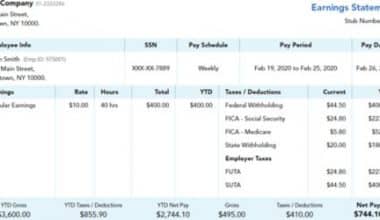Using business budgeting software, you can make sure that your company is on track to reach its financial objectives. Spreadsheets are a popular budgeting tool among some business owners, but there are drawbacks, including manual data entry and the possibility of human error. Business budgeting software might be a better option if you would rather take a more automated approach to the process. The best tools enable you to set up account budgets, monitor budget variances, forecast cash flow, and, in some cases, select from a variety of projection techniques or prepare for worst-case scenarios.
Conveniently, accounting software typically includes tools for creating budgets, but you should link your accounting software with a different budgeting app to gain more in-depth knowledge of methods for increasing revenue and decreasing costs.
Our top picks for business budgeting software tools are listed in this article, along with what makes each one special.
Read Also: WHAT IS A BUDGET? All You Need To Know
What Is Business Budgeting Software?
Business budgeting software is a tool that helps you manage, track, and forecast budgets to understand the financial health of your company. It should have robust reporting capabilities that let you create and manage financial statements like profit and loss statements and cash flow reports, as well as compare actual income and expenses to budgeted amounts.
There are software that delves a little deeper if you want to forecast how a specific business decision might affect your cash flow, even though some accounting software products have budgeting tools. Before exploring your options, think about how factors like pricing, user experience, accounting tools, and more will affect your choice.
Types of Budgeting Software
There are two main types of budgeting software:
#1. Business budgeting software
Business budgeting software helps you manage, track, and forecast budgets to understand the financial state of your company. To map out the financial resources they will need to support their business activities in the future and to help them estimate future revenues and expenses across the business, organizations use budgeting software as part of their financial planning and analysis.
#2. Personal budgeting software
Personal Budgeting Software is a program that can monitor your finances in real-time. It will enable you to create a budget, monitor your spending, prompt you to pay bills and display your balance after deducting expenses and investments, among other things.
Advantages Of Using Budgeting Software
Budgets are created by businesses to cut back on unnecessary spending and save money. You will benefit from using a good business budgeting tool if you:
#1. It aids in budget planning and forecasting for your entire business.
#2. Budgeting software enables you to combine reporting dashboards with your planning and budgeting.
#3. It enables you to control operations and cash flow.
#4. Additionally, it fosters greater cooperation and transparency in your team’s financial planning.
#5. These programs combine financial data with business strategy and decision-making.
#6. Lastly, it keeps your company on track with its financial objectives.
What Are The 4 Types Of Budgeting?
Here, we’ll go into more detail about the four standard budget types used by businesses.
#1. Incremental budgeting
With incremental budgeting, the current year’s budget is created by adding or subtracting a percentage from the actual figures from the previous year. Due to its simplicity and ease of understanding, it is the most popular type of budget. If the main cost drivers remain constant from year to year, incremental budgeting is appropriate.
However, the method’s main flaw is that it’s likely to keep inefficiencies alive. For instance, if a manager knows that he can increase his budget by 20% annually, he will simply take advantage of the opportunity to do so and increase his budget rather than make an effort to find ways to reduce expenses or make savings.
#2. Activity-based budgeting
Activity-based budgeting determines the number of inputs necessary to support the targets or outputs set by the company. It is a top-down type of budget. For instance, a business sets a revenue output goal of $50 million. The business must first identify the tasks that must be completed to hit the sales goal before calculating the associated costs.
#3. Value proposition budgeting
The budgeter takes into account the following issues when using value proposition budgeting:
- Why does this sum appear in the budget?
- Does the product offer value to its users, employees, or other stakeholders?
- Does the item’s worth justify its price? If not, is there another justification for the expense?
Therefore, value proposition budgeting is just a way of thinking about making sure that everything in the budget adds value to the company. Value proposition budgeting attempts to prevent unnecessary spending, though it is less successful than our final budgeting choice, zero-based budgeting.
#4. Zero-based budgeting
Zero-based budgeting is a bottom-up budgeting method that requires managers to justify every expense and avoid unnecessary expenditures. The software aims to avoid expenditures that are not essential to successful operations.
Which Software Is Used For Budgeting And Accounting?
#1. YNAB
YNAB is the best budgeting software for taking control of money due to its combination of flexibility and features. It guides you through making an intentional, forward-thinking plan, and its goal-tracking and reporting features help monitor progress. Even though it is more expensive than its free counterparts, it provides the necessary tools to create a value-driven spending plan.
#2. Honeydue
Honeydue is the best option for couples because it helps them manage their finances together. It allows them to link accounts and customize what information they share, while also communicating about money issues. Notifications alert them to upcoming bills or when they exceed spending limits. It also makes sharing information about money simpler by allowing them to respond to their partner’s transactions and aggregate their linked account information.
#3. PocketGuard
PocketGuard is the best option for college students because it makes it easy to see how much money they have available to spend. Its goal-tracking features an intuitive pie chart to help even beginning budgeters see if they’re on track. Its simple user interface and pie charts make it easy to start budgeting and tracking spending, and its “In My Pocket” feature reduces the risk of overdraft accounts.
#4. EveryDollar
EveryDollar is ideal for families who want to handle their budgeting together, as it allows them to create a budget in less time and allocate every penny they earn. Furthermore, it synchronizes your data across all devices, so everyone can be updated on how expenses are made.
#5. Empower
Empower (formerly Personal Capital) is the best option for investors because it offers robust budgeting software and a retirement and savings planner with tools to track net worth, cash flow, and an investment checkup. It integrates budgeting software with other financial tools in one financial dashboard, allowing users to track spending, monitor investment performance, set retirement goals, and track net worth all in one place.
#6. Albert
Albert is a banking app that automates savings and monitors spending habits. It earns cash back on purchases, can withdraw savings at any time, and can qualify for annual cash bonuses. It creates an automatic budget and provides many reporting options, such as reviewing past months’ budgets or seeing transactions as a pie chart.
#7. Mint
Mint is the best option for beginners because it aggregates all accounts in one place, tracks net worth, and provides add-ons such as access to credit scores. It makes budgeting easy by linking accounts and showing how spending compares to the national average.
Why Use Budget Software?
#1. Better Financial Control –
Cash flow management software provides greater control over business operations and financial control, especially during economic uncertainty. Budgeting software helps keep company finances in check through improved visibility and targeted reviews.
#2. Better Planning Operations –
The budgeting application provides real-time visibility of financial performance, enabling precise investments and forecasts.
#3. Improved Performance Analysis –
Budgeting software can help identify areas for efficiency and productivity improvement, allowing for more value-driven processes.
#4. It Allows For Better Growth Planning –
A growth plan outlines a business’s future ambitions in granular detail, with contingencies and strategies to achieve them in various scenarios. It is essential to keep this in mind during economic instability.
#5. Improved Cash Flow Management –
A budgeting software solution enables a more responsive approach to cash flow management, allowing corrective action to be taken quickly and transparently.
What Are 5 Budgeting Methods?
#1. Zero-based budget
The zero-based budgeting approach starts from scratch: It begins by assuming that every division’s budget has no base and needs to be rebuilt from scratch every financial period.
#2. Incremental budget
One of the strategies that is used the most frequently is incremental budgeting. To obtain the new or current year’s budget plan, all you have to do is modify the current or previous fiscal period’s budget by an amount or percentage.
#3. Activity-based budget
ABB helps businesses understand where their money is being spent and how it is being used.
#4. Value proposition budget
A budget for a value proposition is an amount of money set aside specifically to develop and maintain a value proposition. This budget is used to fund projects like product development, market research, and advertising campaigns. A value proposition budget aims to generate more revenue than the value proposition’s cost to generate a return on investment.
#5. Flexible budget
Flexible budgets can be used to compare actual outcomes with desired levels of activity. These budgets are budgets that can be adjusted based on revenue and cost changes throughout the fiscal year, taking into account expected unpredictability.
Is Excel Good For Budgeting?
The majority of businesses, including government agencies, commercial enterprises, and nonprofits, use Microsoft Excel for budgeting. They can easily gather, organize, manage, and analyze data for forecasting and budgeting using Excel because of its familiarity, flexibility, and ease of use.
Furthermore, and not just because you can completely customize it! Many Excel users discover that building a practical budgeting spreadsheet aids in their ability to understand where their money is coming from (as well as where it is going).
How To Create A Budget In Excel?
To create a budget in Excel, follow these steps if you’d rather use a template:
In Excel, the top ribbon contains the “File” tab. You might have the option to select the “New from template” tab from a drop-down menu or the “New tab” button, depending on the software version you are using. The interface of the computer program is altered by clicking either tab.
#2. Search for budgets
On the new interface, you can anticipate seeing a bar. Enter “Budgets” into the search bar to find it. To finish this step, make sure your internet connection is stable.
#3. Pick a preferred template
You can find a variety of budget templates in Microsoft Excel to suit your needs. The most popular ones are listed below:
- Family budget which helps you visually present the information and track monthly income, expenses, and cash flow.
- Household budget that displays estimated and actual costs for individual items then figures out the difference automatically.
- Event budget which outlines costs, such as those associated with the location, refreshments, and entertainment.
- Business expense budget which aids in financial management for small and medium-sized businesses by calculating line items annually.
- Website budget aids in budgeting your three-year website development costs.
#4. Fill in the template.
Depending on the template you choose, how you finish this step might change. Many have formulas that let you figure out total expenses and costs for a given period. Budget headers frequently include explanations that can guide the kind of information to enter in each column.
DATABASE ADMINISTRATOR: Definition, Role, Salary, How To Become & Internship
BEST BUDGETING APP: The Top 11 Picks in 2023 (Updated)
ZERO-BASED BUDGETING: Meaning, Template, Examples
CASH BUDGET: How To Prepare a Cash Budget






